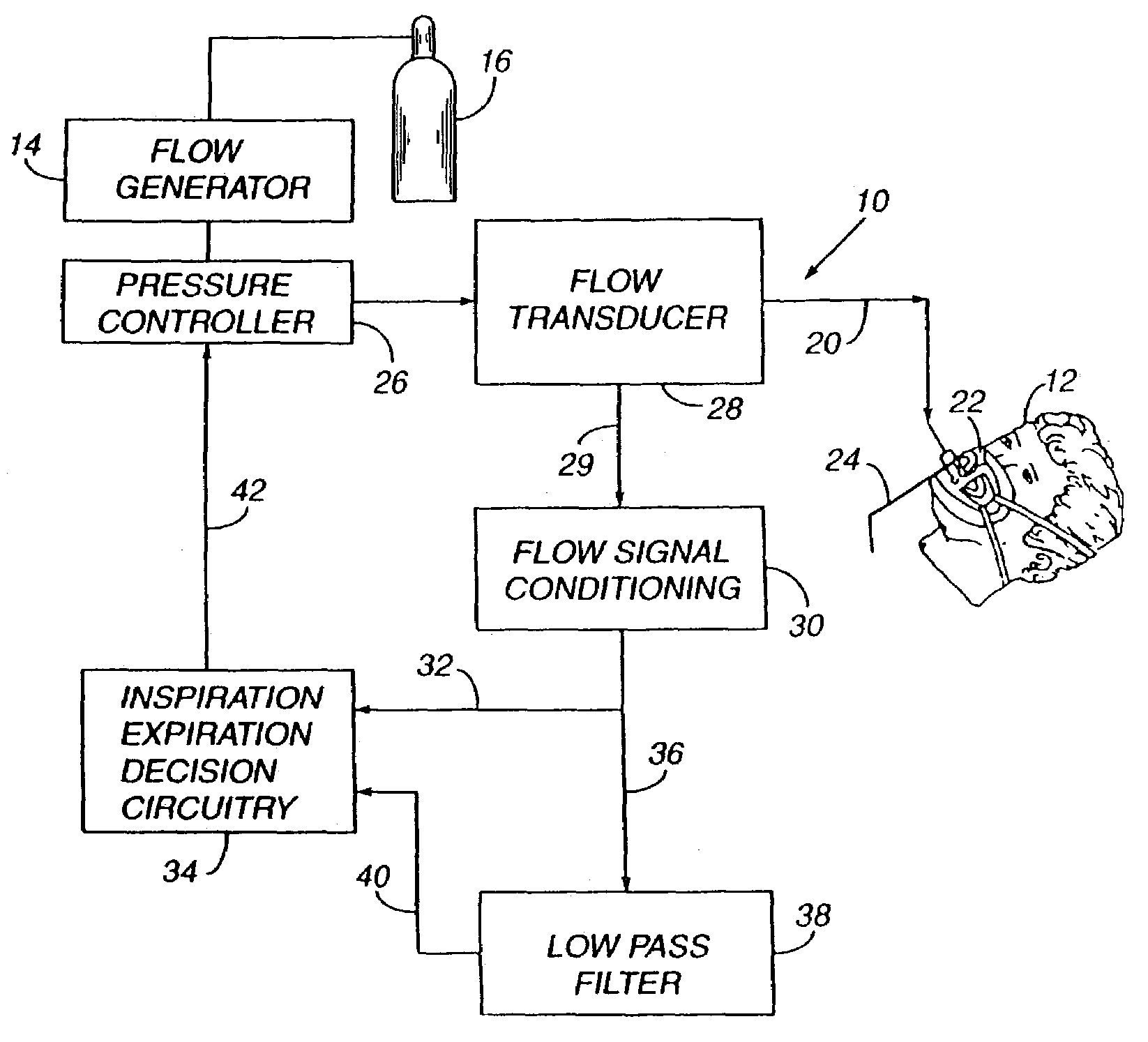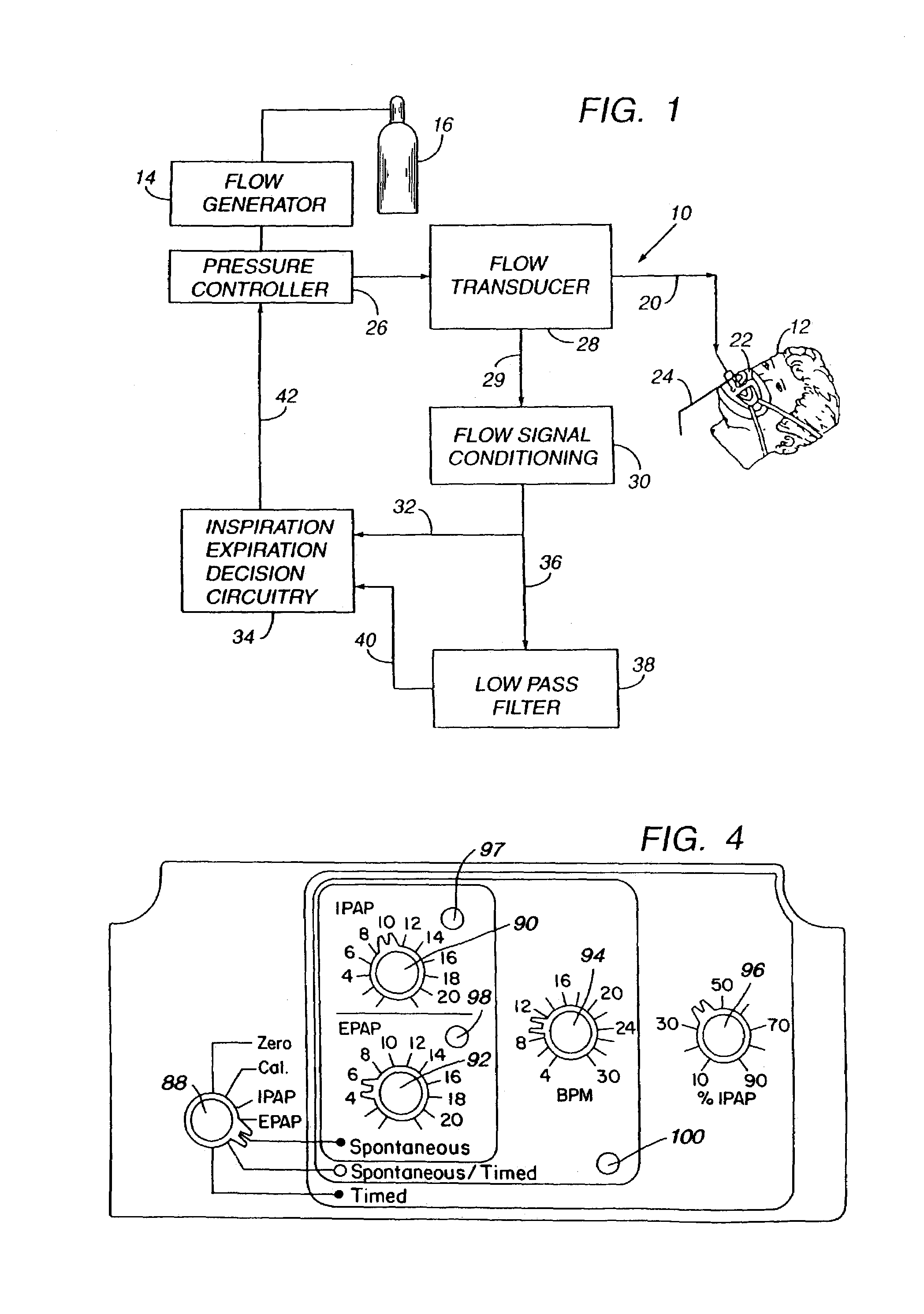[0029]A particular
advantage of the present invention is that the unique ramp circuitry enables not only an initial ramp cycle to be achieved for when one first attempts to sleep but such circuitry also permits one or more additional cycles to be selectively activated by the user at instances where the user awakens during an extended
rest period, or when the user fails to fall asleep during the first ramp cycle and again requires a ramp cycle to fall back to sleep, or even within (i.e., during) an already ongoing ramp cycle. Typically, during a sleeping period of several hours, the time required to once again fall asleep after briefly being awakened is generally less than the time spent initially falling asleep. To accommodate this phenomenon, the ramp circuitry of the instant invention allows adjustment of the
ramp time of any additional ramp cycle to run for a selected fraction of the initial
ramp time, which itself may be a pre-programmed, patient-selected a clinician-selected fraction of a prescription time preset by a health care professional in supervision of the patient's sleep apnea treatment.
[0030]The ramp circuitry enables a physician or other health care worker to set the initial
ramp time(s) and prescription pressure(s). Additionally, however, the novel ramp circuitry of the present invention permits adjustment of the “shape” of the pressure ramp curve, whereby the physician, health care worker or patient can suitably manipulate appropriate controls associated with the ramp circuitry to control the pressure output pattern of the ramp (as represented as a function of pressure versus time) such that it may assume virtually any configuration including, inter alia, linear, stepped, or curvilinear slope, depending upon a patient's particular needs as dictated by the results of the patient's
sleep study. In the case of bi-level systems according to the instant invention, the ramp circuitry also affords, for example, simultaneous, independent, identical or differential ramping of IPAP and EPAP. Alternatively, the parameters establishable by the ramp circuitry may also be preprogrammed by the manufacturer.
[0031]Additionally, sufferers of sleep apnea are sometimes afflicted by other maladies which limit the degree to which they may safely physically exert themselves. An
advantage of the present invention is that it enables a limited-mobility user, at his discretion, to operate the apparatus either by manual controls located directly on the apparatus or via
remote control. Equally as important, it provides any sleep apnea sufferer using the apparatus with the peace of mind of knowing that the pressure can be reduced at any time via the
remote control. Further, the preferred embodiment of the remote control contemplated for use in the present invention is one which the user can operate easily and reliably either in light or
darkness to turn the apparatus on and off as well as selectively activate the first or subsequent ramp cycles.
[0032]As additional or alternative design features, the apparatus may include an automatic ON / OFF mechanism and / or alternative ramp activation means.
[0033]The automatic ON / OFF mechanism desirably comprises a sensor means situated within or
proximate to the patient's
breathing circuit. Such
breathing circuit will be understood to include, but is rot limited to, the gas flow conduit, the gas flow generator means and the respiratory interface, e.g., oral
mask,
nasal mask, oral /
nasal mask,
endotracheal tube, nasal cannulae, or other suitable appliance. The sensor means may assume the form of a pressure, flow, thermal, audio, optic,
electrical current,
voltage, force, displacement or other suitable
transducer which detects the presence (and / absence) of the patient. More particularly, according to a first mode of operation, when the respiratory interface is appropriately positioned over the patient's face, the sensor means will operate so as to detect at least one of the above-mentioned conditions indicative of the patient's presence and generate a
signal that is transmitted to the flow generator to activate the apparatus. In a second mode of operation, the sensor means may be designed solely for apparatus activation purposes. Hence, upon removal of the respiratory interface, the sensor means would fail to detect any conditions indicative of the patient's presence and, therefore, generate an appropriate
signal to deactivate the apparatus. A third mode of operation combines these functions. That is, the sensor means may be operable to detect both the presence and absence of the patient and generate a
signal to activate the apparatus upon detection of a condition indicative of the patient's presence, as well as an apparatus deactivation signal upon failure of detecting such a condition, i.e., the patient's absence.
[0034]The alternative ramp activation means may comprise a sensor means responsive to signals of selected magnitude and / or frequency consciously produced by the patient. In accordance with a presently preferred embodiment, the alternative ramp activations means may comprise a pressure
transducer, for instance, a
microphone located within or near the patient's respiratory interface, associated gas flow conduit or gas flow generator and capable of detecting sound of a limited frequency range spanning that associated with human speech. So configured, the
transducer would be nonresponsive to common ambient sounds produced by the user (e.g., coughing or sneezing), machinery
noise, music or animal sounds. Moreover, by being isolated through its
enclosure within the gas flow
system, the transducer would detect only the patient's speech to the exclusion of others in the vicinity or speech emanating from television or radio sources. Upon detection of the patient's speech such as, for example, when the patient awakens and speaks to start a new ramp cycle, the audio transducer generates and transmits an activation signal to the ramp circuitry to initiate the desired ramp cycle. The sensor may alternatively be operable to begin a ramp cycle in response to detection of a predetermined pattern of inhalations and / or exhalations or other conscious actions by the patient.
 Login to View More
Login to View More  Login to View More
Login to View More 


